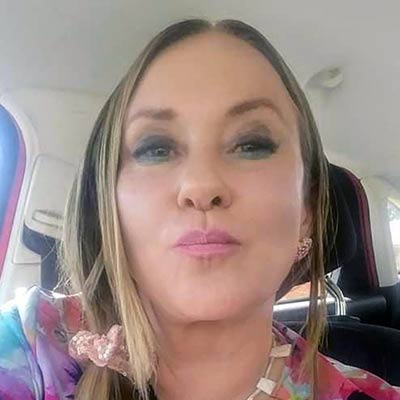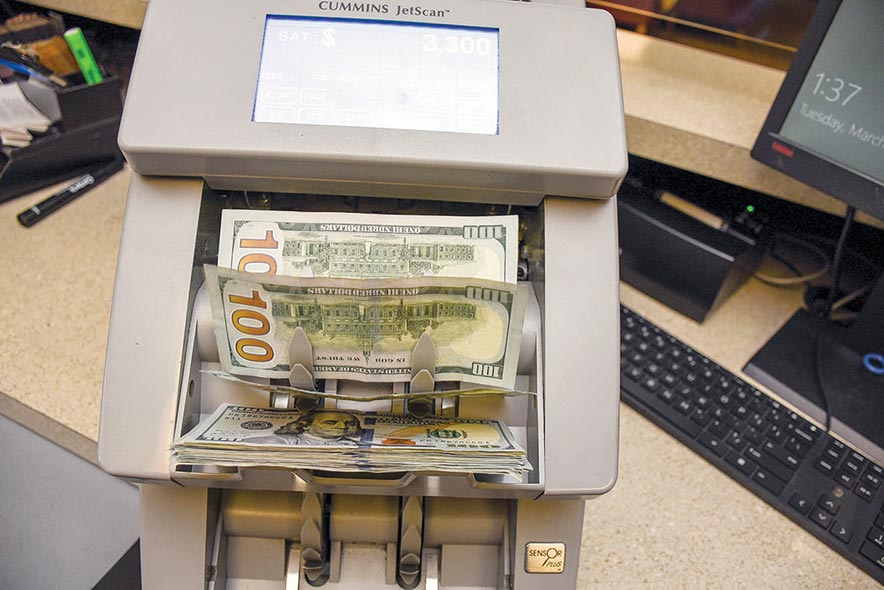

With $111 million left in the Navajo Nation’s American Rescue Plan Hardship Assistance pot, now may be a good time to apply.
After a bumpy rollout of the ARPA Hardship Assistance program last February, the controller’s office is now in a better position to administer the remaining hardship funds to eligible applicants, according to a report shared with the Budget and Finance Committee last week.

Navajo Times | Krista Allen
A woman fans out $2,000 after cashing her ARPA Hardship Assistance check at Wells Fargo in Tuba City on Thursday, March 3. The bank asked the Navajo Times to safeguard customer identity unless the customer was OK with being photographed.
The hardship assistance is intended to provide financial relief to Diné who suffered financial losses because of the COVID-19 pandemic, with payments of $2,000 for adults and $600 for minors.
Through last spring and summer, the understaffed and overwhelmed OOC Hardship Team struggled to keep up with thousands of calls and emails from frustrated applicants who hadn’t received their checks in the mail due to incorrect addresses or problems with their applications or CIBs.
The long lines at the OOC “Returned Check Drives” at various locations on and off the reservation further stoked frustrations.
But now, most of the previous issues have been resolved, and the number of new applicants has slowed down at the Hardship Team Office, according to team lead Wallace James.
“Right now, our doors are open back up to the public,” James said. “We are located at Admin. Building 1 upstairs. We are taking new applicants and we are taking inquiries.”
James said many new applicants are now new tribal enrollees, and his office is averaging 50 new applications per week.
“Every new applicant who comes in, we do process them the same day,” he added.
James said the timeframe for when an applicant applies to when the check is sent out is a few weeks because it goes through verification and quality review before it is approved for a check run.
Emerson Horace, ARPA Hardship accounting supervisor for the controller’s office, reported that since February 2022, 72 check runs had been made, with 337,830 checks paid to eligible Navajo enrollees totaling $558 million as of Sept. 20.
A total of $677 million was allocated to the hardship program by the Navajo Nation Council and President Jonathan Nez to accommodate the Navajo Nation’s estimated 411,000 tribal members.

Navajo Times | Krista Allen
A money counter shuffles bills inside Wells Fargo bank in Window Rock.
James said that his team now has the full support of higher management.
“Mr. Horace is actually our third supervisor with the hardship team,” James said. “Each supervisor had a different view of how the hardship is going to be run.”
Delegate Amber Kanazbah Crotty asked Horace and James to provide information about the current number of outstanding applications.
“What is the plan to assist those individuals who have applied and are waiting for their hardship check?” she asked.
James said the controller’s office resolved a backlog of over 5,000 hardship inquiries from applicants. About 800 outstanding applications have been sent to the controller for quality review.
“As soon as those are filtered out, they will be paid out,” he said.
While his staff of 20 temporary workers still gets hundreds of calls and emails daily, James said they now have a system to address those as quickly as possible.
“We are answering calls on our end,” he said. “Every single day, I have staff who are making callbacks or returning emails.”
James said his team is still working with vital records to resolve the remaining CIB issues, including duplicate CIBs, which can take time.
“We are getting those CIBs corrected, and once we get them corrected, we are adding those applicants on to the listing to get them paid out,” he said.
A group of employees also focused on contacting remaining applicants whose checks were returned.
“We are calling the applicants and informing them that their check has been returned,” he said. “They have the option of coming in, in person and picking up their check in person, or they can give us another address of where we can send the checks to.”
Also, checks that were issued but are now expired are being reissued, said James.
Crotty suggested that by this time, it would have been nice to have an automated Hardship portal available where applicants could enter their name and CIB and check on the status of their application.
“I’m just trying to understand how we can support those relatives who continue to contact delegates,” Crotty said. “When our relatives do not hear a response from the office, then we receive that information.”
James informed the B&F that developing a portal where applicants can go online and see the status of their application and check is in the planning stages.
Horace added that a contract was recently signed with a provider to establish a database of all the Hardship information, which would serve as the foundation of an online portal.
However, Horace said it would take time to organize all Hardship application files and data, including CIB numbers.
Crotty pressed, saying the Controller has millions of dollars to adequately staff the Hardship office and implement adequate technology resources to manage all the hardship applicant information.
She added this would not be the only time the Navajo Nation government will be expected to provide direct communication or services to its people.
“Hopefully, at some point, the government information systems are modernized and reformed so that we’re not in these predicaments,” she said. “This should be a pivot point for our government to be able to identify and know where all of our citizens are.”
Information: www.nnooc.org or call (928) 223-3536 or email ARPA.Hardship@nnooc.org
As a public service, the Navajo Times is making all coverage of the coronavirus pandemic fully available on its website. Please support the Times by subscribing.